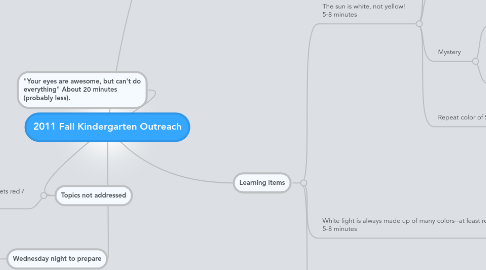
1. "Your eyes are awesome, but can't do everything" About 20 minutes (probably less).
2. Learning items
2.1. The sun is white, not yellow! 5-8 minutes
2.1.1. QUIZ: What color is the sun (raise hands to vote)
2.1.2. We can only look directly at it when there's a sunset, and it looks yellow or magenta then
2.1.2.1. Bring in a yellow filter if I have it
2.1.3. White objects, such as a sheet of paper, white crayon, milk look white and not yellow when we take them outside.
2.1.3.1. Our indoor lights are white so we can see the true colors of objects. Sometimes lights are yellow indoors, and they make things look yellower
2.1.4. Mystery
2.1.4.1. If you put a piece of paper into outer space, what color would it look like on Earth at night?
2.1.4.1.1. You couldn't see it of course--too small!
2.1.4.2. What if we put something really, really, really big into outer space, orbiting the Earth. If it was white, what would it look like at night?
2.1.4.2.1. Is there anything huge that we can see at night?
2.1.4.2.2. Maybe a child will think of the moon
2.1.4.2.3. The moon is white because it's white and the sun's light is white. We can look at it, but we can't look at the Sun (too bright!)
2.1.5. Repeat color of Sun quiz
2.2. White light is always made up of many colors--at least red, blue, and green 5-8 minutes
2.2.1. HANDOUTS/TAKEHOMES -- Diffraction gratings
2.2.1.1. I can bring in a laser pointer to show that the diffraction grating splits light.
2.2.1.1.1. Is it OK to have a volutneer child come up to hold the diffraction grating?
2.2.1.2. Children can look through these and see the indoor lighting split into discrete colors (fluorescent lights) or smooth spectrum (incandescent lights)
2.2.1.2.1. I can give them diffraction gratings to take home
2.2.1.2.2. http://www.amazon.com/Rainbow-Symphony-Diffraction-Grating-Mounted/dp/B001DSGYEO/ref=sr_1_1?ie=UTF8&qid=1314749672&sr=8-1
2.2.1.3. Also, they may be able to see red / blue / green pixels on computer screens that look white
2.2.1.4. They can take these home, and some of them may find them fun to look through at lights in their own homes.
2.2.2. In rainbows, little spherical drops of rain split the sunlight into colors for us
2.2.3. Repeat color of Sun quiz
2.3. Your eyes are so awesome, but they can't do everything 2-5 minutes
2.3.1. Without help (the diffraction gratings or something else), we can't "see" the difference between the two kinds of white light
2.3.2. Quiz: Can you see everything?
2.3.2.1. Maybe mention "imaginary colors"?
2.3.3. Quiz: Can you believe everything you see?
2.3.4. End the lesson by passing out printed optical illusions that they can take home
2.3.4.1. http://www.michaelbach.de/ot/mot_rotsnake/
2.3.4.2. On the handouts, say, "search google for rotating snakes" or something
2.3.4.3. Print on card stock if possible
3. Topics not addressed
3.1. Why is the sky blue? / Why are sunsets red / magenta?
4. Introduction 2 minutes
4.1. I'm so excited to be here, Sammy tells me that there are a bunch of good listeners in this class and that it's and awesome class--that makes me happy.
4.2. I'm a scientist and teacher at UNM. I loved science when I was in school and had great teachers and I loved learning and doing experiments. I'm happy that you children get to learn about science with such great teachers.
4.3. In addition to loving my work (science), I like baseball (me and Sam watch the Tigers), running, and sunshine--today I wanted to talk about some mysteries of sunshine
5. Wednesday night to prepare
5.1. Rotating snakes printouts
5.1.1. Buy cardstock @ office depot
